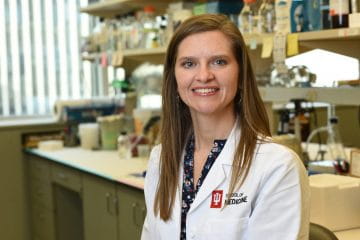Yet, current patients being treated at Indiana University Melvin and Bren Simon Comprehensive Cancer Center can play a pivotal role in changing the outlook for patients who come after them. They do so by literally giving a piece of themselves: donating samples of their tumor, fat, and muscle to researchers at IU School of Medicine.
How vital can a small piece of tissue truly be?

To Melissa A. Fishel, PhD, it’s crucial to better understand the complexity of the disease. So, using a small piece of tissue, she creates a 3D model that grows a microtumor that activates normal cells to help it grow and survive. Meanwhile, another sample can be implanted in a mouse to see how it behaves.
The nuances and diversity of those models, which come from different tumors, are attractive for researchers exploring potential drug compounds. In 2020 alone, six reached out to Fishel’s team to use her model for just that purpose.
“We’re pushing to use patient samples as much as possible to make our research relevant clinically,” said Fishel, who co-leads a group of 20 researchers striving to understand what drives pancreatic cancer, develop tools to detect it, and discover new treatments. “Cancer’s been cured in mice enough, and not enough in humans. That’s our goal.”
It also underscores how truly interconnected pancreatic research is at IU School of Medicine. The talent of its surgeons attracts one of the nation’s largest patient volumes. Those surgeons have close relationships with basic scientists and understand the value of patient involvement.
Additionally, the school also performs genomic analysis on every patent seeking treatment. That precise DNA portrait does more than tailor therapy. It creates a trove of information researchers can analyze and link with the models they make.
In the case of Teresa Zimmers, PhD, who also co-leads the group, it’s possible to attach a precise figure to patient involvement: $6.6 million. That’s the direct grant support her group has received using tissue samples to study cachexia, a condition where muscle and fat tissue waste away.
Her group has shown that an overactive protein, which usually alerts our immune system to fight an infection, is a crucial driver of cachexia. Some pancreatic tumors secrete high levels of that protein, causing rapid loss of fat tissue. As that unfolds, lipids are also released, traveling with the protein to muscle tissue, causing it to break down.
Tissue samples were vital in explaining that cascade – and helped foster an NIH-backed project with the Medical University of South Carolina. Together, the labs will see whether they can block that protein. For Zimmers, it underscores how patents influence IU’s collective expertise, resources, and results, making it attractive to collaborators elsewhere.
“It’s not just within Indiana that they affect change,” Zimmers said of patents who contribute samples. “It’s improving research in places far outside, and it’s why we’ve been able to make a great leap that’s never really happened before.”
Philanthropic support is also crucial. No matter how large, a contribution enables talented surgeons, dogged oncologists, and brilliant basic scientists to do just a little more.
“It’s being able to use systems that are a little more sophisticated,” Fishel said. “It demands a little bit more intensity. It lets us move the needle a little bit more. We have some exciting and innovative ways to look at this disease, find new targets, and create new drugs.”